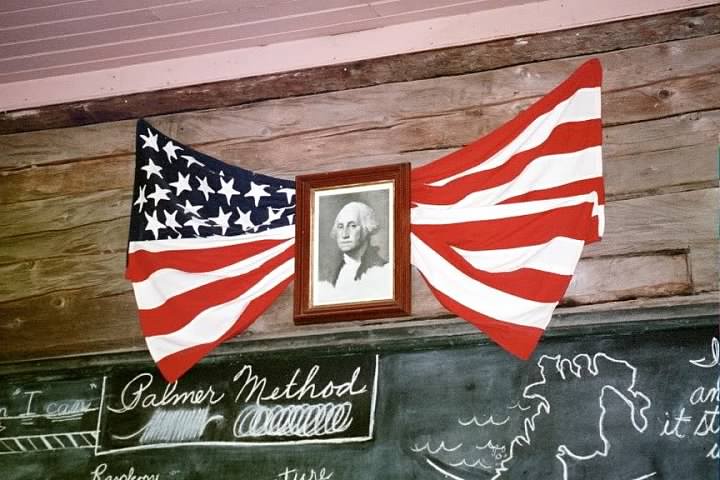Celebrations of Independence Day feature prominently in both Farmer Boy and in Little Town on the Prairie. In Little Town especially they go into great detail and even quote some of the Declaration of Independence which is read in full during the service. The scene culminates with Laura having an internal dialogue where she realizes “…when I am a little older, Pa and Ma will stop telling me what to do and there isn’t anyone else who has a right to give me order. I will have to make myself be good….This is what it means to be free.” Followed up by Almanzo and the Morgans winning a thrilling horse race.
Communities Read the Declaration
This part of the scene about the Declaration is often cited as an example of Rose’s editorial work having spun out a brief mention into a drawn out scene. Reading the Declaration of Independence used to be an important part of civic 4th of July celebrations. In fact, it was one of the things Laura says she memorized. In communities around the country people would come together and listen to speeches and someone would read the Declaration. While it was much closer to people in the 1880s (just barely over a hundred years after it was signed), making the Declaration part of your celebration of the holiday is a good reminder what it’s all about. When I worked at Ushers Ferry in the 1990s the Old-Fashioned Independence Day was always a popular event and it was topped off by a reading of the Declaration and it was a good tradition.
Read the Declaration on July 4th
The conservative, private Hillsdale College has launched an initiative to put the Declaration back in the holiday by asking people to sign a pledge saying they will read it on the Fourth of July. Rose would definitely approve.
Even if you want to avoid the Hillsdale connection, you can still read the Declaration. The National Archives have both images of the original document and a transcript on their website about the charter documents of this country.
What Exactly Is In It?
If you haven’t read it lately, remember that the purpose of the Declaration was to declare Independence from Great Britain. This sort of thing just wasn’t done at the time and so people who saw themselves as educated gentlemen, part of the cosmopolitan Enlightenment Age, they felt the need to justify their actions. So after the beautiful beginning part, much of the middle is a listing of King George’s crimes, both those legitimately his fault and some that were a stretch. Of Parliament they are completely silent since they had no representation there, they held that they were exempt from Parliament’s control and as such they ignored its actions completely. However, there was a strong British tradition of having a representative say in the government and as such they formed a representative body to help govern themselves in each individual colony and then eventually as a weak federal body, since they didn’t want to overthrow Parliament’s control for a similar version on this side of the Atlantic. Then they give it a strong end by pledging to each other “to each other our Lives, our Fortunes and our sacred Honor.” And if that makes you want to learn more about the Revolution and what they were trying to accomplish, try Common Sense by Thomas Paine which you’ve probably heard about, but may never have read. Or check out some of the many, many books that have been published on our Founding Fathers. Or Rose’s own (somewhat flawed in its historical accuracy) Discovery of Freedom.
Avoid Declaration Myths
July 4th wasn’t the day that the Declaration was signed. The founders, especially John Adams who wrote about his vision, expected July 2nd to be the day of celebration. July 2nd was the day that the Continental Congress voted to declare their independence from Great Britain. July 4th was when the wording of the actual document was approved, but the first signatures didn’t appear until the printed copies arrived in August and they continued to be added for months after that.
Despite Jefferson including its authorship on his tombstone, Thomas Jefferson did NOT write the document alone. Although Jefferson contributed much to the wording he borrowed heavily from other political and philosophical writing of the day that he expected his audience to be just as familiar with. Then evidence clearly shows the other committee members, John Adams and Benjamin Franklin contributed both ideas and words. Then Congress got in the act and changed enough so that after the war Jefferson included his original version in published papers, not the one with Congressional “corrections.”
Watch out for stories too good be to true about the fates of the signers and the great John Hancock signing story but the story of a windfall find of a copy is true.
Sarah S. Uthoff blogs at TrundleBed Tales; look for her on Twitter and YouTube and Blog Talk Radio
Laura Ingalls Wilder Legacy and Research Association, Vice-President and Membership Chair


Comment1
Good post!
Comments are closed.